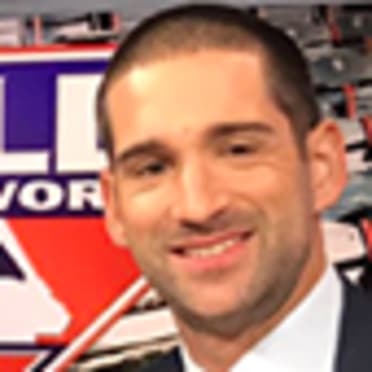Each club's best prospect success of decade
Player development success stories come from a variety of sources. The best player of the 2010s, Mike Trout, was both talented enough to merit going in the first round and underrated enough to last 25 picks in the 2009 Draft. Getting taken in the first round came with lofty expectations -- and he blew them away by a greater margin than anyone could have guessed.
We identify each team's development highlight for the past decade below, a list that includes several first-rounders. There also are several other players with far more modest pedigrees, such as the 5-foot-6 infielder who went from a $15,000 bonus out of Venezuela to win an MVP Award and three batting titles, or the 31st-round junior college product who became a three-time Gold Glover.
AMERICAN LEAGUE EAST
Blue Jays: Marcus Stroman, RHP -- The No. 22 overall pick in the 2012 Draft made his big league debut less than two years later -- after ranking the No. 55 prospect on MLB Pipeline’s preseason Top 100 Prospects list -- and subsequently emerged as a stalwart in Toronto’s rotation, posting a 3.76 ERA in 789 2/3 innings across six seasons before going to the Mets via trade last July. The 28-year-old righty turned in his best season in 2017, when he recorded a 5.3 WAR and finished eighth in the AL Cy Young race.
Orioles: Manny Machado, 3B/SS -- Machado reached the Majors as a 19-year-old in August 2012, a little more than two years after the Orioles made him the No. 3 overall Draft pick. He garnered AL All-Star honors the following year and ultimately compiled 31 WAR over parts of seven seasons in Baltimore (36.9 WAR overall) before departing via trade in 2018 and inking a 10-year, $300 million pact with San Diego prior last offseason. Altogether, the 27-year-old Machado has produced a .279/.335/.483 line with 207 homers -- he’s hit at least 32 in five straight years -- and 232 doubles across his first eight seasons.
Rays: Kevin Kiermaier, OF -- Selected in the 31st round of the 2010 Draft out of the Illinois junior college ranks, Keirmaier was already revered for his elite outfield defense before blooming as a hitter during his 2014 rookie campaign. And while the 29-year-old’s production has backed up a bit in the past two years, he still managed to compile at least a 2 WAR in both years and has been a 26.2-WAR player for Tampa Bay across seven seasons.
Red Sox: Mookie Betts, OF -- Boston liked Betts more than most teams, projecting him as an athlete with plus hitting ability and speed, not to mention strong instincts and makeup. He lasted five rounds in the 2011 Draft as a Tennessee high schooler because other clubs wondered about his impact potential -- even the Red Sox had some scouts who questioned his power -- and batted just .267/.352/.307 in his first extended taste of pro ball in 2012. He broke out the following year, claimed a starting job in Boston by mid-2014 and since has garnered a World Series ring, an MVP Award, a batting title, four All-Star Game berths, four Gold Gloves and three Silver Sluggers since.
Yankees: Aaron Judge, OF -- The 32nd overall pick in the 2013 Draft, Judge was the second of New York's three first-round picks that June, getting selected between Eric Jagielo (No. 18) and Ian Clarkin (No. 33). He had obvious power potential, yet he homered just 18 times in three years at Fresno State and 56 times in three full Minor League seasons as he employed a gap-to-gap approach. Once he began focusing more on crushing the ball, he set an AL rookie record with 52 homers in 2017.
AMERICAN LEAGUE CENTRAL
Indians: Francisco Lindor, SS -- When Cleveland took Lindor with the eighth overall choice in the 2011 Draft as a Florida high schooler, scouts viewed him as a future Gold Glover with at least solid hitting ability and plus speed. He delivered on all of those projections but blew away all expectations for his power. After totaling just 21 homers in 416 Minor League games with a season high of six, he has slammed 103 in the last three years and become one of MLB's best all-around players.
Royals: Salvador Perez, C -- Perez leads all Royals prospects in WAR this decade (22.3), and that’s without a single game played in 2019. The backstop has been a six-time All-Star and won five Gold Gloves. As a prospect, he was a bit overlooked, sneaking in at No. 10 on the Royals’ list in 2011, the year he made it to the big leagues.
Tigers: Eugenio Suárez, 3B -- Signed out of Venezuela in 2008, Suarez was ranked as the Tigers’ No. 7 prospect going into ‘14 -- the same year that he had a nondescript debut in Detroit before joining the Reds via an offseason trade. He’s improved offensively in every season with Cincinnati, totaling 143 homers during his five years in the organization, including a career-high 49 homers this past season, which also marked his second straight 100-plus RBI, 4-plus WAR campaign.
Twins: Brian Dozier, 2B -- The expectations for Dozier, an eighth-round pick out of Southern Mississippi in 2009, weren’t very high, but boy, did he exceed them. The Twins’ No. 14 prospect at the start of the 2012 season, he made his big league debut that season just shy of his 25th birthday. He’s since gone on to post six seasons with 20 homers or more (with a career high of 42 in 2016) en route to a WAR of 24.5 entering the 2020 season.
White Sox: Chris Sale, LHP -- After starring at Florida Gulf Coast and in the Cape Cod League, Sale should have been regarded as the best college pitching prospect in the 2010 Draft, but teams got hung up on his low arm slot and worried that he might not be able to last as a starter. Chicago stole him with the 13th overall choice that June and brought him to the Majors two months later as a reliever. Once he moved to the rotation in 2012, he earned seven straight All-Star Game selections, won a pair of strikeout crowns and a World Series ring with the Red Sox.
AMERICAN LEAGUE WEST
A's: Matt Chapman, 3B -- A strong case can certainly be made to choose Josh Donaldson here, but here’s predicting Chapman eventually eclipses him. The 2014 first-round pick already has compiled a WAR of 18.5 in three years (and he didn’t come up until mid-June in 2017), finished in the top 10 in MVP voting in each of the last two years while winning Gold Gloves in both of those seasons and making his first All-Star team in 2019. In case you were wondering, Donaldson’s WAR over his first three seasons? 16.7.
Angels: Mike Trout, OF -- This one was a tough choice … just kidding. The all-everything outfielder’s 72.5 WAR is second among ALL active players, not just those who were prospects this decade. What the 2009 first-round pick who was No. 1 on the 2011 Top 50 prospects list and No. 3 to start 2012 has done has been well-documented, and he’s still only 28.
Astros: José Altuve, 2B -- As a 5-foot-6 second baseman with no discernible power, Altuve attracted little attention and merited just a $15,000 bonus when Houston signed him out of Venezuela in 2007. He didn't receive a lot of hype while climbing toward the big leagues, and even though he led the Minors with a .389 average and appeared in the Futures Game in 2011, he still wasn't considered a can't-miss prospect. A three-time batting champion and six-time All-Star, he also owns a World Series ring and Gold Glove -- and his career-high 31 homers in 2019 were one more than he totaled in seven years in the Minors.
Mariners: Kyle Seager, 3B -- The Mariners took Seager in the third round of the 2009 Draft out of North Carolina, then watched him reach the big leagues two years later. While his offensive numbers have waned of late, he still has eight straight seasons of 20 or more homers on his resume and his 30.4 WAR easily leads any M’s prospect this decade.
Rangers: Joey Gallo, OF/1B -- No player signed and developed by Texas who graduated to the Majors during the 2010s accrued more WAR than Leonys Martin's 11.9 -- the lowest total for any franchise leader. Gallo eventually should eclipse that mark, though he came with huge swing-and-miss concerns when the Rangers made him the 39th overall pick in the 2012 Draft after he set a Nevada high school record with 65 career homers. He still strikes out a ton, with 593 whiffs in 416 big league games, but he also has slammed 110 homers during that span.
NATIONAL LEAGUE EAST
Braves: Ronald Acuña Jr., OF -- Freddie Freeman (37.4 WAR) deserves a shoutout, but every once in a while a prospect so dynamic comes along that he can’t be ignored, even if he only has two big league seasons under his belt. Acuña certainly fits that description with a Rookie of the Year Award in 2018, a Silver Slugger and All-Star appearance -- while falling three steals short of a 40-40 campaign -- in 2019.
Marlins: Christian Yelich, OF -- Miami produced not one but two MVPs in the last decade, and Yelich gets the nod here over Giancarlo Stanton. He presented a challenging profile to scouts as a hit-over-power high school first baseman, though the Marlins believed enough in his bat to draft him 23rd overall in 2010. He made an easy transition to the outfield in pro ball, though his pop didn't fully manifest itself until he got traded to the Brewers in 2018 -- and he has been the best player in the National League ever since.
Mets: Jacob deGrom, RHP -- Before becoming perhaps the best pitcher in baseball, deGrom was a ninth-round pick in the 2010 Draft out of Stetson University, where he’d spent three years as a two-way player. The Mets moved him to the mound full time in pro ball, and after losing a season to Tommy John surgery, deGrom returned to action and steadily evolved into a true ace. The 31-year-old righty claimed his second straight NL Cy Young Award in 2019 -- also his third straight campaign tossing at least 200 innings -- and has compiled 32.7 WAR during his first six seasons.
Nationals: Bryce Harper, OF -- The biggest Draft pick of the decade (No. 1 overall in 2010) has become one of the sport’s biggest stars, garnering six All-Star selections, an MVP Award (2015) and an historic 13-year, $330 million contract during his first eight seasons. Overall, the 27-year-old has amassed 31.5 WAR, slashing .276/.385/.512 with 219 homers and 635 RBIs in 1,084 games.
Phillies: Aaron Nola, RHP -- The Phillies took Nola No. 7 overall in the 2014 Draft as a college pitcher with advanced pitchability who could get to the big leagues in a hurry. He didn’t disappoint, making his Major League debut just over a year after being drafted and he now sits atop the Phillies rotation. The right-hander finished third in Cy Young Award voting and made his first All-Star team in 2018 and has now topped 200 innings in two straight seasons en route to 20.3 WAR in less than five full seasons.
NATIONAL LEAGUE CENTRAL
Brewers: Lorenzo Cain, OF -- Milwaukee’s 17th-round pick from the 2004 Draft didn’t reach the Majors until 2010 and was shipped off to Kansas City after the season in the Zack Greinke trade. He showed steady improvement early in his Royals career before breaking out in 2015, when he finished third in the AL MVP voting and led Kansas City to a World Series title. He finished seventh in the NL MVP race in 2018, his first year in Milwaukee after signing a four-year pact as a free agent, and then finally won his first Gold Glove this past season. Altogether, Cain has been a 36.9-WAR player in 10 seasons.
Cardinals: Matt Carpenter, 3B -- A 2009 13th-rounder from Texas Christian, Carpenter was unheralded as a Draft prospect but quickly hit his way through the Cardinals' system to reach the Majors in June 2011. He emerged as an everyday player for St. Louis in 2012, finishing sixth in the NL Rookie of the Year race after entering the season as the club’s No. 11 prospect. Since then, Carpenter has been an All-Star on three occasions and twice recorded a top 10 finish in the circuit’s MVP voting. His 26.7 WAR tops all Cardinals prospects this decade.
Cubs: Kris Bryant, 3B -- Unlike many players on this list, Bryant didn't exceed expectations so much as he lived up to Chicago's hopes for him when it selected him No. 2 overall in the 2013 Draft. He outhomered 223 of the 296 NCAA Division I teams as a San Diego junior that spring, won the Arizona Fall League MVP Award at the end of his pro debut, then led the Minors with 43 homers and was the consensus Minor League Player of the Year in his first full pro season. The three-time All-Star won the NL Rookie of the Year Award in 2015 and the NL MVP Award and a World Series title as an encore.
Pirates: Gerrit Cole, RHP -- The No. 1 overall pick in the 2011 Draft out of UCLA, Cole was the Pirates’ No. 2 prospect at the start of 2012 and rose to the top spot in 2013 and rose as high as No. 9 on the overall Top 100 list at the start of that ’13 season. That’s also when he arrived in Pittsburgh and played a hand in helping the Pirates make it to the postseason in 2013-15. He’s now made three All-Star teams and finished in the top five in Cy Young Award voting three times (2015, 2018-19).
Reds: Aroldis Chapman, LHP -- Chapman topped the Reds’ list at the start of the 2011 season and quickly established himself as one of the top closers in baseball after that. The Reds had swooped in and signed the hard-throwing Cuban defector in January 2010 and he made his big league debut that season. Since then, he’s been named to six All-Star teams and has seven seasons of 30 saves or more, winning the Mariano Rivera AL Reliever of the Year Award in 2019.
NATIONAL LEAGUE WEST
D-backs: Paul Goldschmidt, 1B -- An eighth-rounder out of Texas State in 2009, Goldschmidt never ranked as an MLB Pipeline Top 100 Prospect before making his big league debut in August 2011. It was the beginning of what has become an accolade-filled career for Goldschmidt, who’s clubbed 243 home runs en route to 43.1 WAR in nine seasons (40.3 in eight seasons with Arizona.). The D-backs ultimately traded their homegrown slugger to St. Louis after the 2018 season, though not before he made six straight NL All-Star teams, won three Gold Gloves and recorded three top 3 finishes in the MVP Award voting.
Dodgers: Cody Bellinger, OF/1B -- Bellinger had a pretty left-handed stroke and big league bloodlines, yet he lasted four rounds as an Arizona high schooler in 2013 because he was lanky and had yet to exhibit the power teams wanted at first base. He struggled in his pro debut and hit just three homers in his second pro season, then effortlessly changed his stroke and approach and went deep 30 times in his third. That foreshadowed a then-NL rookie record 39 homers in 2017 and 47 more in 2019, when he won an MVP Award and a Gold Glove in right field.
Giants: Buster Posey, C -- Outside of needing to clean up his receiving because he only had caught for two years, Posey was pretty much a fully formed prospect when San Francisco selected him with the No. 5 overall pick in 2008 out of Florida State. He made a cameo with the Giants at the end of 2009 and joined them for good by the end of May in 2010, when he won the NL Rookie of the Year Award and a World Series championship. By the end of the decade, he collected two more World Series rings, an NL MVP Award, a batting title and six All-Star Game berths.
Padres: Fernando Tatis Jr., SS -- Acquired from the White Sox in June 2016 in the widely panned James Shields trade, Tatis might not seem like the obvious choice for this article since he’s played less than a full season in the Majors. However, his rise to top-prospect stardom -- he entered 2019 as MLB Pipeline’s No. 2 overall prospect after checking in at No. 8 the previous year -- combined with his immediate impact as a 20-year-old rookie and future potential make him San Diego’s most important prospect of the decade. Specifically, Tatis racked up 4.2 WAR in just 84 games, slashing .317/.379/.590 with 22 homers and 16 steals en route to a third-place finish in the NL Rookie of the Year voting.
Rockies: Nolan Arenado, 3B -- Arenado was a second-round pick out of high school in 2009 and topped out at No. 22 on the overall Top 100 at the start of the 2012 season, topping the Rockies' list that year (he was No. 2 in 2013). He came up to Colorado in 2013 and stayed, earning Rookie of the Year votes and the first of his seven straight Gold Glove Awards. He’s been an All-Star five years running and has four Silver Sluggers as well while compiling 38.7 WAR in seven seasons as he’s hit 37 or more homers and driven in at least 110 runs for five consecutive seasons.


